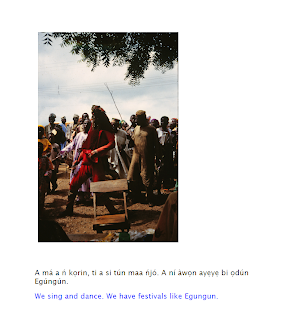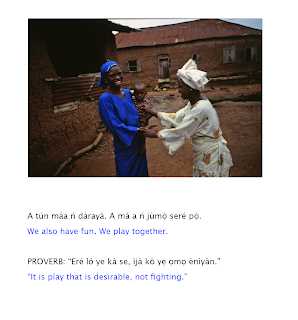Monday, March 25, 2013
Online Book: Funmilayo of Ara 1
Funmilayo of Ara
English and Photographs by Lance M. Foster
Yoruba Translations and Proverbs by Dr. Larinde Akinleye
Copyright 2013
-
DEDICATION
This little book is dedicated to the memory of my friends and teachers: Mike and Mary Warren, Dr. Larinde Akinleye, and to Funmilayo and her family, and the good people of the town of Ara. Wherever each of them are, may God smile upon them and watch over them.
-
INTRODUCTION
In the summer of 1996, while a graduate student at Iowa State University, I traveled to Nigeria as part of a team studying indigenous health knowledge systems of the Yoruba through an NIH (National Institute of Health) grant program, MIRT, administered through Michigan State University.
Dr. D. Michael Warren, at that time part of the faculty of the Anthropology Department at Iowa State University, was the team leader. Dr. Warren was a leader in the study of Indigenous Knowledge Systems (IKS), and their potential to empower the peoples of the Third World.
Dr. Warren’s wife Mary Salawuh Warren was a Yoruba woman of royal lineage in Ara, and her ancestors founded Ara centuries ago. They worked tirelessly to help improve the lives of the people of Ara.
Tragically, Dr. Warren died in December 1997, of health complications, in his beloved town of Ara, and is buried there. Mary Warren moved to Ghana and died there in 2011.
THIS BOOK
This online book tells about the daily life of Funmilayo Akinokun, a Yoruba woman who lives in the traditional Oyo Yoruba town of Ara, in Nigeria, in West Africa. It was developed from events in her life as told by Funmilayo herself in 1996. The bilingual story about Funmilayo was developed in collaboration during the late summer of 1996 with Dr. Larinde Akinleye of the Department of Communications Studies at the University of Ibadan, who was the team’s instructor in the Yoruba language. Dr. Akinleye was also a well-known actor in Nigeria’s film industry.
I lived part time in Ara, during which time I developed the story with Funmilayo, and took the photographs. I had wanted to do something to honor the people there, and Dr. Warren suggested a book about Funmilayo and her family would be good. Funmilayo and Femi were helpers of the Warrens. I also painted an outdoor mural at the Big Leaf bar in Ara, a place that served beer, with a Mami Wata, and hunters drinking beer with bush animals and Igbo Iwin (forest spirits).
When I returned to Ibadan, I worked with Dr. Akinleye in developing the Yoruba translation that summer. We worked back and forth between English and Yoruba, collaborating in a way to tell a story that would make sense in both Yoruba and American English. Dr. Akinleye also supplied traditional Yoruba proverbs and their translations, appropriate to the text. Proverbs are fundamental to traditional Yoruba culture, and have various levels of meaning.
This text was further developed for publication in 1998, after the death of Dr. Warren, but various life circumstances intervened, including the lack of an interested publisher, and it was put in storage for over a decade. I never returned to Nigeria, and I lost contact with Dr. Akinleye.
In 2011, I was going through various boxes in storage and found the text and slides again. With the digital publishing revolution of the last decade, I decided to scan the slides, re-visit the text, and contact Dr. Akinleye through email.
However I soon learned that Dr. Akinleye tragically died in an automobile accident in Ibadan in 2004. He was a noted actor in the “Nollywood” (Nigerian) film industry. I even located a movie he starred in that had been uploaded called “Thunderbolt (Magun).” This was a story of the strains of an interethnic marriage between a Yoruba and an Igbo, and the curse that resulted from baseless jealousy and the tragic result. Dr. Akinleye played one of the major characters, the headmaster of the school. I recognized my old friend and teacher immediately, and was glad to see him at top form in the film, though of course I was also saddened at the loss.
Ara is off the beaten path, and it is hard to get news of the people who live there. I have recently heard that Funmilayo’s husband Femi died some years ago, and it would not be surprising to learn of other tragedies. As noted by a Yoruba proverb quoted by Dr. Akinleye: ““Aye le ọ run ko see lọ.” - “Life is hard, but to go to heaven is not easy.”
THE YORUBA
The Yoruba are one of the three largest ethnic groups of Nigeria, the other two being the Ibo (or Igbo) and the Hausa-Fulani. The Yoruba constitute the majority of the population of southwestern Nigeria, the region traditionally called Yorubaland. The Yoruba people have always been very social people, living in towns and cities for hundreds of years, with the family compound the basic social unit.
The Yoruba were one of the most victimized African groups during the slave trade, and many Yoruba were captured and made slaves by Europeans, Arabs, and Americans, and became part of the forced African diaspora, the scattering of African peoples in the New World. As a result, Yoruba language and culture has made its influence felt all over the world, notably in Cuba and Brazil.
THE YORUBA LANGUAGE
The Yoruba language, composed of numerous dialects, is a tonal language like Mandarin Chinese, and thus has a very musical nature. Yoruba is pronounced with such tones, as Yorùbá. Yorùbá has three tones in its use: low (falling) tone (`), mid-tone (unmarked), and high (rising) tone (´), that correspond to the musical tones “do-re-mi.” Proper intonation is crucial in Yorùbá, as the intonation of a word carries much meaning (semantic implications). For example igbá means “calabash,” ìgbà means “time,” and igba means “200.” The dialect used by Dr. Akinleye in this story was marked by him with the proper tones, and is the dialect known as Oyó, or standard Yorùbá.
In my brief time in Nigeria, I did learn some Yoruba, but I am by no means a real speaker of the language, having learned mainly some basic greetings and terms. Dr. Akinleye did his best and was an excellent teacher, and whatever I was able to learn about the Yoruba language, was due to his tireless and kind efforts.
Because I cannot figure out if it is possible to show the Yoruba font correctly in all browsers and on all platforms, I will present each page of the book separately as an image, including the text with diacritical marks (the various tones,etc.).
CONTENTS (This is the easiest way to read the book in the proper order, so you can bookmark this page for reading and to forward to other people)
page 1: Introduction (you are here)
2: Funmilayo
3: Ara
4: House
5: Family
6: Work
7: Work 2
8: Marketplace
9: Sewing
10: Peppers
11: Marketplace 2
12: Farm
13: Home
14: Daycare
15: Library
16: Play
17: Talk
18: Festival (Egungun)
19: Church
20: Shrine of Ogun
21: Hunter
22: Life is Hard
23: My Town (End)
Subscribe to:
Comments (Atom)























